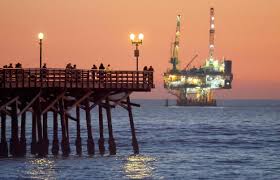Biden’s Bold Move: Shutting Down Offshore Oil and Gas Drilling Before Trump Can Reverse It
President Biden is using executive authority to safeguard over 625 million acres of U.S. ocean waters from offshore drilling, the White House announced.
U.S. President Joe Biden has announced plans to prohibit new offshore oil and gas development along the majority of U.S. coastlines, aiming to limit future fossil fuel expansion in sensitive maritime areas. This policy decision could pose significant challenges for President-elect Donald Trump, who has pledged to ramp up domestic energy production during his upcoming term.
The ban, however, is largely seen as a symbolic gesture rather than a sweeping shift in energy policy. It will not affect regions where active oil and gas extraction is already taking place, nor will it disrupt ongoing operations. Instead, the restrictions primarily target areas in the Atlantic and Pacific Oceans where drilling companies currently hold little interest or viable prospects for oil and gas development.
While the move aligns with Biden’s environmental protection goals and efforts to curb fossil fuel reliance, it may face political pushback, as Trump has signaled intentions to prioritize expanding U.S. energy independence and increasing fossil fuel output once in office. The long-term impact of the ban remains uncertain, given the limited economic consequences and the possibility of future administrative reversals.

On Monday, the White House announced that President Joe Biden will invoke his authority under the Outer Continental Shelf Lands Act, a law enacted nearly 70 years ago, to impose sweeping protections on federal waters across multiple U.S. coastlines. This historic move will prohibit new offshore oil and gas development across vast regions, including the entire East Coast, West Coast, the eastern portion of the Gulf of Mexico, and specific areas of the northern Bering Sea in Alaska. In total, the ban will safeguard approximately 625 million acres (253 million hectares) of ocean, marking one of the most extensive federal protections of offshore waters in U.S. history.
President Biden emphasized that this decision is closely tied to his broader environmental and climate policy goals. It aligns with his administration’s commitment to combating climate change by reducing reliance on fossil fuels and preserving ecologically sensitive areas. Additionally, the move supports Biden’s ambitious “America the Beautiful” conservation initiative, which aims to conserve 30% of the nation’s lands and waters by the year 2030.
While the protective measure will prevent new offshore drilling projects in these federal waters, it does not impact existing energy operations. Nonetheless, it represents a significant step toward the administration’s long-term sustainability objectives, prioritizing oceanic biodiversity and climate resilience while limiting future fossil fuel extraction in critical marine ecosystems.
President Biden referenced the devastating 2010 Deepwater Horizon oil spill in the Gulf of Mexico as a key reason behind his decision, emphasizing the severe environmental and economic consequences such disasters can inflict. He argued that the limited oil and gas potential in the regions covered by the ban does not justify the significant public health and financial risks associated with future offshore drilling leases.
In a formal statement, Biden highlighted that his decision aligns with the long-standing concerns of coastal communities, local businesses, and beachgoers, who have consistently voiced opposition to offshore drilling near their shores. He stressed that such activities could cause irreversible harm to cherished natural areas and ecosystems while offering minimal benefits for the country’s energy security.
“My decision reflects what communities along our coasts have long understood — that offshore drilling in these areas poses unacceptable risks and is unnecessary for meeting the nation’s energy demands,” Biden declared. “The potential damage simply isn’t worth it.”
Approximately 15% of U.S. oil production currently originates from federally controlled offshore areas, with the majority concentrated in the Gulf of Mexico. However, this share has significantly declined over the past decade as onshore oil drilling has surged, according to data from the U.S. Energy Information Administration (EIA).
The United States has now become the world’s leading producer of oil and natural gas, largely driven by a substantial rise in output from states like Texas and New Mexico. This production boom has been fueled by advancements in drilling technology, such as hydraulic fracturing and horizontal drilling, alongside heightened global demand for energy following Russia’s invasion of Ukraine, which disrupted international supply chains.
The announcement of Biden’s offshore drilling ban comes at a time when President-elect Donald Trump has vowed to roll back Biden’s environmental and climate policies once he assumes office later this month.
In a recent interview on the Hugh Hewitt radio show, Trump criticized the decision, calling it “ridiculous” and pledging to overturn it swiftly. “I’ll unban it immediately. I have the right to unban it immediately,” he stated, signaling his intention to reverse the ban as part of his broader energy agenda.
Throughout his presidency, Biden has also imposed restrictions on new oil and gas leasing across both federal lands and waters, a move that has faced considerable backlash from energy-producing states and drilling companies, who argue the policies could harm domestic energy production and economic growth.


Comments are closed, but trackbacks and pingbacks are open.